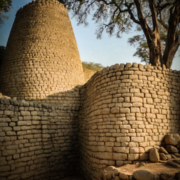
Passionate about getting God's message concerning Afrika and the end…
Read Next
ARE THEY WILD OR JUST UNCORRUPTED?
Frankly speaking, we do not think there is anything wild, including fruits. Wild fruits are just normal fruits that have not been compromised or tampered with by the greed of man. And here is why we said so. To the Maasai and the many other nomadic communities that roam the plains and savannahs of East Africa with their cattle, these so-called wild fruits are just normal fruits and for thousands of years, they have lived and thrived with these fruits both as food and medicine.
Anyways, here is a list of African fruits considered wild.
1. Aizen (Mukheit)
The aizen or mukheit (Boscia senegalensis, Capparaceae) occurs in a vast swath across the top of sub-Saharan Africa, from Somalia in the east to Mauritania in the west. Usually a scrawny shrub, it occupies some of the hottest and driest locations faced by plant life. Yet aizen not only survives, it also yields an array of useful products—enough indeed to sustain human life almost by itself. In at least a dozen countries, people at times virtually live off aizen’s fruits, seeds, roots, and leaves. Although not unpleasant to eat, the fruits are most notable for being available when little else remotely edible is to be found. In addition, the seeds extracted from within those fruits are cooked and dried and become such common dietary items that they have been described as desert dwellers’ staples.
2. Chocolate Berries
Several of the nearly 70 Vitex species (Labiatae) found scattered across tropical Africa produce fruits of local importance. These small and rugged trees are quintessential wild food resources. In season, they become
bespangled by an abundance of blackish fruits, which passersby eagerly gather up. The reason? Although the uninitiated may disdain the pungent scent and stained lips, almost everyone loves the “chocolate” flavor.
3. Custard Apples
The plant family botanists call Annonaceae produces fruits crammed with a sweet pulp with a custard-like texture. These tropical delights are sold the world around under names such as “custard apple,” “cherimoya,” or “sops” of various vintages. They are already among the most beloved fruits in tropical Asia and America, but so far the African members have been neglected and are poorly understood even within their natural habitats. What might be called “the lost sops” deserve further development, not to mention protection from disappearance. One, the African custard apple, has been called “the best indigenous fruit in most parts of tropical Africa.” Another, the junglesop, produces probably the family’s biggest fruits—as long as a forearm and as thick as a thigh. A third—perhaps the strangest of all—”hangs like a bunch of sausages,” each fruit a separate bright-scarlet link.
4. Ebony
The jet-black, rock-hard heartwood known as ebony is perhaps the smoothest, shiniest, and most beautiful of all the woods; renowned worldwide for expensive carvings, it is regarded as almost a precious material and can sell by the gram. But Diospyros, the name of these trees’ genus, actually means “fruit of the gods,” and outside the tropics, ebony species are most renowned for the persimmon. In their domicile in the wild, African members of the Family Ebenaceae also produce widely enjoyed fruits. And they could be much more widely enjoyed. The fruits have advantages: They are suitably sized for marketing on a large scale, attractive to look at, and appealingly succulent and sweet. They are, however, very soft and delicate. This fragility is at present the biggest—perhaps the only—barrier to ebony fruits becoming a valuable, everyday, Africa-wide food.
5. Gingerbread Plums
Within virtually the whole of sub-Saharan Africa—the vast stretch of territory between Senegal and Madagascar—there exist a number of interrelated wild fruits (Parinari and kindred genera of the Family Chrysobalanaceae) with agreeable strawberry-like flavours. These so-called gingerbread plums can have a texture firm enough to crunch like a crisp apple. Usually red or yellow in color, these plum-sized delicacies lack the sourness typical of wild fruits (and of true plums, for that matter). Millions of aficionados, notably children, love their crunchy sugariness, and consume them in quantity.
6. Gumvines
Some of the roughly 17 Landolphia species (Family Apocynaceae), occurring mainly in West and Central Africa, bear masses of fruits that make tasty morsels. These “gumvine fruits” or “rubber fruits” look somewhat like apricots, with tough skins that are red, yellow, or orange in color. The plants themselves are common and are obviously at home in the African environment. They are forest lianas and sprawly shrubs nowadays admired for their jasmine-scented flowers as much as for their plentiful fruits or the latex-filled stems that once provided Europe and other parts of the world with much of their rubber.
7. Icacina
Icacina (Icacina oliviformis, Icacinaceae) is a small, drought-resistant shrub forming dense stands in the West African and Central African woodlands and plains. Although the species is truly wild, several million people rely at various seasons upon its separate products: fruits, seeds, and tuberous roots. The fruits are usually consumed fresh. Bright red and plumlike, they have a sweet and pleasant flavor. The plants grow so densely and yield so exuberantly that during the season a family can reportedly collect hundreds of kilos of fruits a day, even from untended wild stands. The small, round seeds from the center of the fruits are also edible. And the huge edible roots are so much like a much better-known staple that their common name in English is “false yam.”
8. Imbe
Food and travel writers commonly elevate Asia’s mangosteen into the lofty level of “world’s most delicious fruit.” However, the plant producing it happens to be only one of 400 Garcinia species found across Asia and Africa. Africa’s best-known member is the imbe (Garcinia livingstonei, Guttiferae), a crooked tree whose soft and colourful fruits brighten up markets from Senegal to South Africa. This small, orange-coloured delight provides a juicy pulp that has a pleasantly sweet-to-acid flavor. East Africans have dubbed it “King of Fruits.” Even those specimens that are unusually sour prove notably appealing on a hot afternoon.
9. Medlars
In East, Central, and Southern Africa at least eight species of Vangueria (Family Rubiaceae) commonly grow with surprising vigor in dry, eroded, infertile, leached, or otherwise challenging sites. These trees closely resemble one another in both appearance and a propensity to bear lots of fruits. For want of any popular name in English, they are called wild medlars or African medlars. The fruits dry easily (even drying out before they are picked), after which they take on the aroma and flavor of dried apples. Reconstituted with water and a little sugar, they substitute for applesauce as well as being used as fillings in puddings and many more culinary products.
10. Monkey Oranges
Three monkey oranges (Strychnos cocculoides, S. spinosa, and S. pungens, Strychnaceae) produce fruits that are large, flavorful, easy to handle, and often desperately difficult to find due to overwhelming demand.
Farmers appreciate the trees so much that when clearing land they spare the ax—even when that will hinder their subsequent field operations. Of all Africa’s wild fruit trees, these are the most “conventional” in appearance and usage. They are similar in size and shape to apple, pear, and orange trees. Given horticultural attention, monkey oranges probably can be raised with equal facility. Already, they bear their fruits in abundance.
11. Star Apples
In many tropical American countries, especially in the Caribbean, the star apple (Chrysophyllum cainito) is a common dooryard tree whose apple-sized delights provide a sweet flesh with small seeds arranged in a star pattern.
What is not well known is that the area below the Sahara contains more than a dozen related species. These attractive trees of the genus Chrysophyllum and Bequaertiodendron (Family Sapotaceae) create their own edible counterparts whose smooth green, purple, apricot, yellow, or copper-coloured skin encloses a white, sweet, tasty pulp. This pulp is arranged in segments and, when cut transversely, typically displays the star-shaped seed arrangement that constitutes the family crest.
12. Sugarplums
Africa is home to more than 30 species of wild fruit trees belonging to the genus Uapaca (Phyllanthaceae; also placed in Euphorbiaceae or Uapacaceae). Several produce flavorful, attractive fruits that engender enthusiasm wherever they occur. These delights add a sweet yet tangy zest to traditional foods from porridges to desserts. Fully ripe, these are plumsized, yellow-brown in color, juicy, and honeylike in taste.
13. Sweet Detar
Throughout much of tropical Africa the detar tree (Detarium senegalense, Leguminosae) is common and its round brown pods well known. At first sight these fruits look like apricots, but physically they are more like tamarinds, with a crisp shell enclosing a rather flaky greenish pulp that makes good eating. As with tamarinds (see Part 1), sweet detars are especially enjoyed in West Africa. Most are eaten fresh, but some are dried in the sun and sold in the markets like dates. The hard shell and dry pulp give them an exceptional shelf life and the sweet-and-sour flavor appeals to most every palate.
14. Tree Grapes
About 40 different trees of the genus Lannea (Family Anacardiaceae) are to be found in the tropics of Asia and Africa. The species in Asia have received horticultural attention, but the 20 or so that are native to locations from Madagascar to The Gambia remain unmoved by modernity. Yet at least a dozen of these wild fruits could be valuable future food resources. Although belonging to the same plant family as mango, cashew, and pistachio, their fruits are more like grapes in form. They come in pendulous bunches and are reddish, purple, or black in color with a whitish bloom on the skin. Although some have a resinous taste, many have a pleasant flavour described as truly “grape-like.”
Now, it is clear from all indications that organic fruits are good for our health and we need to incorporate more of them into our diet. But here is another fruit that I also want to talk about.
Just as fruit is the direct consequence of a tree, either good or bad, so are many of the sicknesses, and diseases in our world the direct consequences of our misuse of life and nature. I think that, for there to be massive amounts of hospitals, pharmaceutical companies and huge budgets for health care is not a sign of health or development but a sign of a sick and dying world. Same way, the so-called climate change and all the noise around it was not because nature just decided to go after humanity all of a sudden. No. Climate change and the change in nature are the direct consequences of our greed, evil, and diabolic use of our natural environment. They are the fruit of our waywardness and the capitalist mindset that we carry about while calling it development. We cannot eat our cake and still have it in our hands.
So, while we do our best to up our intake of more natural and organic fruits from Africa, we must also think of the consequences of our actions as Africans and how the fruit of such actions is the bedrock upon which our so-called underdevelopment is hinged.
In conclusion, I encourage you to do your due diligence, search online for the nutritional values of each of the fruits I have mentioned, and see how to fully incorporate them into your diet.
Subscribe now for updates from Msingi Afrika Magazine!
Receive notifications about new issues, products and offers.
What's Your Reaction?
 PIN IT
PIN ITPassionate about getting God's message concerning Afrika and the end times to the world, in order to heal, restore and rebirth Afrika to her true purpose and destiny in God.














